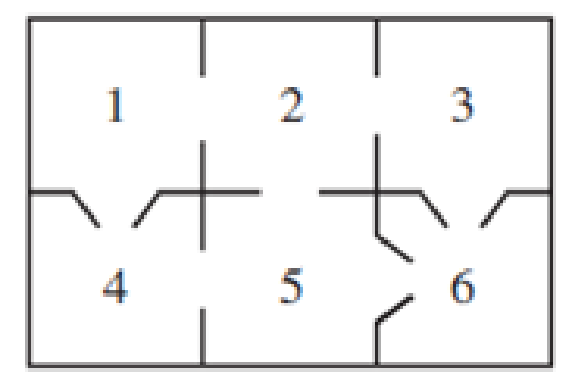
Consider the mouse in the following maze from Section 10.1, Exercise 19.

Find the communication classes for the Markov chain that models the mouse's travels through this maze. Is this Markov chain reducible or irreducible?
In Exercises 19 and 20. suppose a mouse wanders through the given maze, some of whose doors are “one-way”: they are just large enough for the mouse to squeeze through in only one direction. The mouse still must move into a different room at each time step if possible. When faced with accessible openings into two or more rooms, the mouse chooses them with equal probability.
19. The mouse is placed in room 1 of the maze shown below.
- a. Construct a transition matrix and an initial probability
vector for the mouse’s travels. - b. What arc the probabilities that the mouse will be in each of the rooms after 4 moves?

Want to see the full answer?
Check out a sample textbook solution
Chapter 10 Solutions
Thomas' Calculus and Linear Algebra and Its Applications Package for the Georgia Institute of Technology, 1/e
- Explain how you can determine the steady state matrix X of an absorbing Markov chain by inspection.arrow_forward2. A rat runs through the maze shown below. At each step it leaves the room it is in by choosing at random one of the doors out of the room. 1 2 3 4 10 5 6 What are the communicating classes for this Markov chain? Are they periodic? Justify your answer.arrow_forwardIf A is a Markov matrix, why doesn't I+ A+ A2 + · · · add up to (I -A)-1?arrow_forward
- A Markov chain model for a species has four states: State 0 (Lower Risk), State 1 (Vulnerable), State 2 (Threatened), and State 3 (Extinct). For t 2 0, you are given that: 01 zit = 0.03 12 t= 0.05 23 Hit = 0.06 This species is currently in state 0. Calculate the probability this species will be in state 2 ten years later. Assume that reentry is not possible. (Note: This question is similar to #46.2 but with constant forces of mortality) Possīble Answers A 0.02 0.03 0.04 D 0.05 E 0.06arrow_forwardConsider the Markov chain X given by the diagram 0 10 1 12 2 FO 2 a) Write down the (1-step) transition matrix of the Markov chain. b) Calculate (manually) the n-step transition matrices of X (remember from linear algebra that matrix powers are best computed by diagonalizing the matrix first and realizing that the power has only to be applied to the diagonal part).arrow_forwardCan someone please help me with this question. I am having so much trouble.arrow_forward
- Please do Exercise 2 part A and B and please show step and explain. Topic of this question is Markov Chainsarrow_forwardA Markov system with two states satisfies the following rule. If you are in state 1 then of the time you change to state 2. If you are in state 2 then of the time you remain in state 2. At time t = 0, there are 100 people in state 1 and no people in the other state. state 1 Write the transition matrix for this system using the state vector v = state 2 T = Write the state vector for time t = 0. Vo Compute the state vectors for time t = 1 and t = 2. Vị = V2arrow_forwardRobots have been programmed to traverse the maze shown in the figure below and at each junction randomly choose which way to go. (a) Construct the transition matrix for the Markov chain that models this situation. 1 3 4 1 2 3 1 Ø 3 4 2 3 0 1/2 1/2 0 1/3 0 1/3 1/3 2 1/4 1/4 0 1/2 0 (b) Suppose we start with 27 robots at each junction. Find the steady state distribution of robots. (Assume that it takes each robot the same amount of time to travel between two adjacent junctions.) 1/3 2/3 0arrow_forward
- Construct the Markov diagram for this game and show that the associate transition matrix T can be written as the following. Show that λ = 1 is an eigenvalue of T. If can answer both (a)and(b), else answer (b).arrow_forwardSuppose a math professor collects data on the probability that students attending a given class meeting will attend the next one. He finds that 95% of students who attended a given class meeting will attend the following class meeting and that 25% of students who do not attend attend a given class meeting will not attend the next one. Build a discrete dynamical system model using linear algebra. Be sure to state your transition matrix explicitly. What percentage of students does your model predict will be attending class meetings by the end of the semester (in the long run)?arrow_forwardPlease help me with this question attached below. Thank you.arrow_forward
 Elementary Linear Algebra (MindTap Course List)AlgebraISBN:9781305658004Author:Ron LarsonPublisher:Cengage Learning
Elementary Linear Algebra (MindTap Course List)AlgebraISBN:9781305658004Author:Ron LarsonPublisher:Cengage Learning
